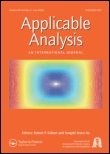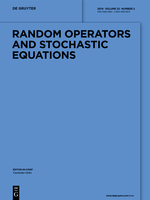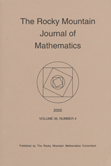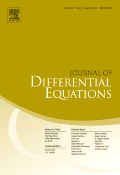
Fractional Calculus and Applied Analysis
Scope & Guideline
Connecting Theory to Practice in Fractional Calculus
Introduction
Aims and Scopes
- Fractional Differential Equations:
The journal emphasizes the study of fractional differential equations, exploring their existence, uniqueness, and properties. This includes both linear and non-linear equations, and their applications in various fields such as physics, engineering, and finance. - Numerical Methods and Approximations:
There is a strong focus on the development and analysis of numerical methods for solving fractional differential equations. This includes collocation methods, finite difference methods, and other computational techniques that enhance the accuracy and efficiency of solving these equations. - Applications in Various Fields:
The journal covers a wide range of applications of fractional calculus in fields such as physics, biology, finance, and engineering. This includes modeling phenomena that exhibit memory and hereditary properties, which are better represented using fractional derivatives. - Theoretical Developments:
Theoretical advancements in fractional calculus, including new definitions, properties, and frameworks, are a core area of interest. This also encompasses the exploration of fractional operators, inequalities, and stability analysis. - Interdisciplinary Approaches:
The journal encourages interdisciplinary research that combines fractional calculus with other mathematical fields, such as stochastic processes, control theory, and optimization, highlighting the versatility and applicability of fractional calculus.
Trending and Emerging
- Fractional Stochastic Analysis:
There is an increasing focus on fractional stochastic differential equations and their applications in finance and physics. This trend highlights the importance of incorporating randomness and uncertainty into fractional models. - Complex Systems and Nonlinear Dynamics:
Research on fractional calculus applied to complex systems and nonlinear dynamics is gaining traction. This includes studies on chaos, bifurcations, and control of nonlinear fractional systems, showcasing the applicability of fractional calculus in real-world complex phenomena. - Interdisciplinary Applications:
Emerging themes include interdisciplinary applications of fractional calculus in fields such as epidemiology, economics, and environmental science. This trend reflects the growing recognition of the utility of fractional models in addressing complex problems across various disciplines. - Advanced Numerical Techniques:
There is a notable trend towards the development of advanced numerical techniques for fractional differential equations, including adaptive methods and machine learning approaches. This reflects a demand for more efficient and accurate computational tools. - Fractional Control Theory:
The application of fractional calculus in control theory, particularly in the design and analysis of fractional-order controllers, is increasingly popular. Researchers are exploring the benefits of fractional control strategies in enhancing system performance and stability.
Declining or Waning
- Basic Theoretical Studies:
There seems to be a waning interest in purely theoretical studies of fractional calculus without direct applications. Researchers are increasingly seeking practical applications and numerical methods rather than solely focusing on theoretical frameworks. - Static Models:
The frequency of publications focusing on static models of fractional calculus is decreasing. This shift may indicate a broader interest in dynamic systems and time-dependent models that incorporate memory effects. - Simple Fractional Operators:
Research on basic fractional operators, such as the Riemann-Liouville and Caputo derivatives, is becoming less frequent. Instead, there is a trend towards more complex and generalized fractional operators that account for various boundary conditions and nonlocal effects.
Similar Journals

APPLICABLE ANALYSIS
Unveiling the future of applied analysis.APPLICABLE ANALYSIS, published by Taylor & Francis Ltd, is an esteemed journal dedicated to advancing research in the fields of analysis and applied mathematics. With its ISSN 0003-6811 and E-ISSN 1563-504X, the journal has been a cornerstone of scholarly communication since its inception in 1971, with a convergence of content projected until 2024. Belonging to the Q2 category for both Analysis and Applied Mathematics as of 2023, it ranks impressively at #58 out of 193 in the field of Mathematics Analysis and #274 out of 635 in Mathematics Applied Mathematics as per Scopus metrics. Although the journal currently does not offer Open Access, it continues to provide valuable insights and cutting-edge research that is vital for academics, professionals, and students who seek to deepen their understanding and application of analytical techniques in various contexts. Its commitment to high-quality research plays a significant role in shaping the landscape of modern mathematics.

Fractal and Fractional
Innovative Research at the Intersection of Fractals and CalculusFractal and Fractional is a prestigious open access journal published by MDPI since 2017, dedicated to advancing the study of fractals and fractional calculus, crucial fields that bridge mathematics, physics, and engineering. With an E-ISSN of 2504-3110 and based in Switzerland, this journal serves as a vital platform for disseminating cutting-edge research and innovative applications. As of 2023, it holds an impressive Q2 quartile ranking in multiple categories including Analysis, Statistical and Nonlinear Physics, and Statistics and Probability, placing it among the top tier of academic publications. Researchers will find valuable insights into contemporary issues within its scope, supported by robust metrics such as Scopus rankings which highlight its significant impact in the fields of Mathematics and Physics. Since its inception, Fractal and Fractional has garnered a reputation for quality and accessibility, making it an essential resource for academics and practitioners engaged in the exploration of complex systems and mathematical phenomena.

Computational Methods for Differential Equations
Fostering Collaboration in Differential Equation MethodologiesComputational Methods for Differential Equations is a prominent academic journal dedicated to the exploration and application of computational techniques in the realm of differential equations. Published by UNIV TABRIZ, this open-access journal has been providing unrestricted access to groundbreaking research since 2013, making it a valuable resource for the global academic community, particularly in Iran. It has carved out a niche within the fields of Algebra and Number Theory, Applied Mathematics, and Numerical Analysis, maintaining a Q3 quartile ranking in 2023 across these categories. Researchers, professionals, and students alike will find the journal's commitment to disseminating innovative computational methodologies essential for advancing knowledge and developing robust solutions to complex mathematical problems. With its ISSN 2345-3982 and E-ISSN 2383-2533, the journal ensures wide visibility and accessibility, serving a diverse audience and promoting scholarly discourse.

Random Operators and Stochastic Equations
Bridging Theory and Application in MathematicsRandom Operators and Stochastic Equations, published by WALTER DE GRUYTER GMBH in Germany, is a pivotal journal dedicated to the exploration of stochastic processes and their applications in various fields of mathematics and statistics. With its ISSN 0926-6364 and E-ISSN 1569-397X, this journal has been a platform for researchers since its inception in 1993 and is anticipated to continue until 2024. Although it currently holds a Q4 category ranking in both Analysis and Statistics and Probability for 2023, it provides invaluable insight and contributions that cater to both academic circles and practical applications. The journal is accessible via traditional subscription methods, making it a crucial resource for professionals and students seeking rigorous research in stochastic analysis. As it navigates through novel developments and theoretical advancements, Random Operators and Stochastic Equations stands as a significant forum for scholarly dialogue in its field.

Qualitative Theory of Dynamical Systems
Advancing Knowledge in Applied and Discrete MathematicsQualitative Theory of Dynamical Systems, published by SPRINGER BASEL AG, is a prestigious academic journal that serves as a central platform for the dissemination of research in the realms of applied mathematics and discrete mathematics. With an ISSN of 1575-5460 and an E-ISSN of 1662-3592, this journal has established itself with a strong impact, ranking in the Q2 category for both applied mathematics and discrete mathematics and combinatorics as of 2023. Having converged over critical years—from 1999 to 2005 and from 2008 to 2025—it aims to publish high-quality, peer-reviewed articles that contribute to the understanding of dynamical systems through qualitative methods. With a Scopus rank placing it in the top twenty of discrete mathematics and combinatorics as well as a respectable position in applied mathematics, the journal is considered essential for researchers, professionals, and students looking to stay abreast of the latest theoretical and practical advancements in these vibrant fields. While the journal currently does not offer open access options, its commitment to rigorous scientific inquiry and innovation ensures its lasting significance in mathematical literature.

Journal of Analysis
Empowering Ideas in Number Theory and GeometryThe Journal of Analysis, published by SPRINGERNATURE, serves as a crucial platform for disseminating advanced research in the fields of mathematics, particularly focusing on Algebra, Number Theory, Analysis, Applied Mathematics, Geometry, Topology, and Numerical Analysis. Since its inception in 2016, this journal has aimed to foster knowledge-sharing and innovation among researchers, professionals, and students. Boasting a diverse scope and a commitment to high-quality research, the journal is indexed in various categories with rankings that reflect its growing influence, particularly in Algebra and Number Theory (Q4), Analysis (Q3), and Applied Mathematics (Q3), among others. With an ISSN of 0971-3611 and E-ISSN of 2367-2501, it offers insightful articles that contribute to the ongoing discourse in mathematics. The journal is located in Germany, ensuring a European perspective while also welcoming global contributions. Researchers seeking to enhance their understanding and impact in their respective fields will find this journal an invaluable resource.

Applied Mathematics in Science and Engineering
Pioneering Research at the Intersection of Theory and Practice.Applied Mathematics in Science and Engineering is a prestigious academic journal published by TAYLOR & FRANCIS LTD, dedicated to presenting innovative research at the intersection of applied mathematics, science, and engineering disciplines. Since its inception as an Open Access platform in 2022, this journal has empowered researchers worldwide to disseminate their findings without barriers, enhancing knowledge-sharing among scholars, professionals, and students. Covering a wide range of topics, including but not limited to mathematical modeling, computational methods, and engineering applications, Applied Mathematics in Science and Engineering aims to foster interdisciplinary collaboration and advance the field through high-quality research articles. With a commitment to rigorous peer review and academic excellence, this journal serves as an essential resource for anyone seeking to stay at the forefront of applied mathematics in contemporary scientific inquiry.

AIMS Mathematics
Exploring diverse areas of mathematics with open-access insights.AIMS Mathematics, published by the American Institute of Mathematical Sciences (AIMS), is a premier open-access journal that has been providing a platform for innovative research since its inception in 2016. With a keen focus on diverse areas within the field of mathematics, this journal aims to disseminate high-quality studies that cater to both theoretical and applied aspects of mathematics. As evidenced by its impressive Scopus rank of 52 out of 399 in the category of General Mathematics, placing it in the 87th percentile, AIMS Mathematics stands as a significant contributor to the academic discourse in this discipline. The journal operates under Q2 in Mathematics (miscellaneous) for its 2023 category quartiles, reflecting its rigorous peer-reviewed process and substantial impact on current mathematical research. Accessible since its launch, the journal's open-access model ensures that researchers, professionals, and students alike can easily retrieve insights and advancements in mathematics, fostering collaboration and the advancement of knowledge globally.

ROCKY MOUNTAIN JOURNAL OF MATHEMATICS
Championing Rigorous Research in MathematicsROCKY MOUNTAIN JOURNAL OF MATHEMATICS, published by the Rocky Mountain Math Consortium, serves as a critical platform for researchers and practitioners in the field of mathematics since its inception in 1971. With a notable presence in the academic community, this journal covers a broad spectrum of mathematical disciplines, positioning itself in the Q2 category for Mathematics (miscellaneous) as of 2023. Despite being a subscription-based journal, it is recognized for its rigorous peer-review process and contributions to theoretical and applied mathematics, helping to advance knowledge and foster collaboration among mathematicians. The journal's ISSN number is 0035-7596 and its E-ISSN is 1945-3795, reflecting its commitment to accessibility and dissemination of high-quality research. Based in Tempe, Arizona, at Arizona State University, the journal continues to play an important role in shaping contemporary mathematical discourse through well-researched articles and innovative studies, aiming to bridge gaps between various mathematical subfields and engage a diverse audience, including students and established researchers alike.

Journal of Differential Equations
Unveiling Insights in Applied MathematicsJournal of Differential Equations, published by ACADEMIC PRESS INC ELSEVIER SCIENCE, is a leading academic journal established in 1965, dedicated to advancing the field of differential equations. With an impressive impact factor that illustrates its significant influence, the journal ranks in the Q1 category in both Analysis and Applied Mathematics, reflecting its high-quality research and contributions to the discipline. The journal is well-respected, holding prominent positions in Scopus rankings, including Rank #14 in Mathematics - Analysis and Rank #118 in Mathematics - Applied Mathematics, both indicating exceptional impact in their respective fields. Although the journal operates on a traditional publication model without an Open Access option, researchers, professionals, and students will find a wealth of vital research articles that address both theoretical and practical aspects of differential equations. As the journal continues to publish cutting-edge work through to 2024, it remains essential for those looking to deepen their knowledge and engage with the latest findings in this dynamic area of mathematics.